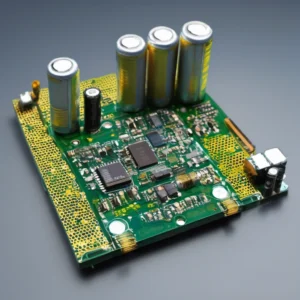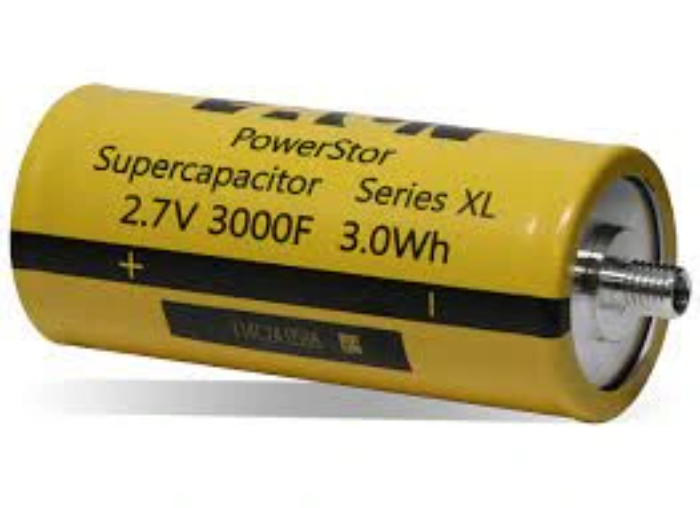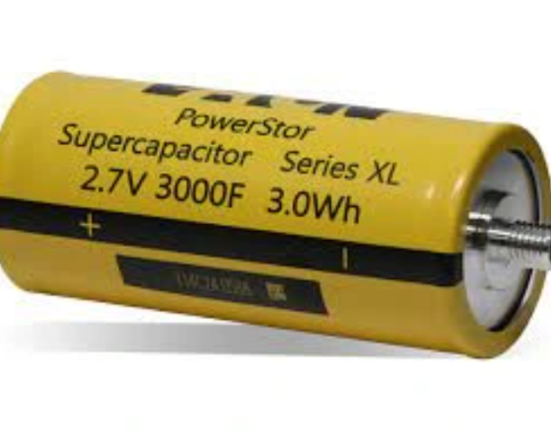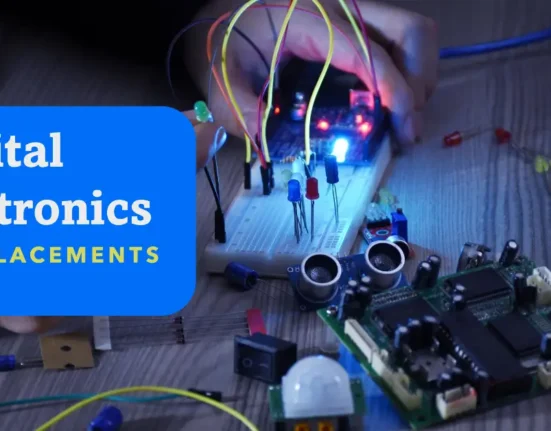Introduction:
Supercapacitors, also known as ultracapacitors are advanced energy storage devices that offer unique advantages over traditional batteries. Unlike batteries, which store energy through chemical reactions, supercapacitors store energy electrostatically, allowing for rapid charge and discharge cycles with minimal degradation. This distinctive capability makes supercapacitors well-suited for applications requiring high power density, fast charging, and long cycle life. In recent years, supercapacitors have gained significant attention for their potential to revolutionize energy storage in various fields, including renewable energy systems, transportation, consumer electronics, and industrial applications. As research continues to improve their performance and reduce costs, supercapacitors are poised to play a pivotal role in advancing sustainable energy solutions and powering the technologies of the future.
Working Principle:
The working principle of SCs involves storing electrical energy in an electric double layer formed at the interface between a solid electrode and a liquid electrolyte. This process occurs through two main mechanisms: double-layer capacitance and pseudo-capacitance.
1. Double-layer capacitance:
When a voltage is applied across the SC electrodes, ions from the electrolyte are attracted to the surface of the electrodes, forming layers of positive and negative charges. This electric double layer creates capacitance, allowing the SC to store electrical energy electrostatically. The capacitance (Cdl) of the double layer is given by the equation:
Cdl=ϵA/d
Where:
- ϵ is the permittivity of the electrolyte,
- A is the surface area of the electrode,
- d is the distance between the electrode and the electrolyte.
2. Pseudo-capacitance:
Some SC electrodes, particularly those made of transition metal oxides or conducting polymers, can undergo faradaic redox reactions when charged or discharged. This additional charge storage mechanism contributes to the overall capacitance of the SC and is known as pseudo capacitance.
The total capacitance (Ctotal) of a SC is the sum of the double-layer capacitance (Cdl) and the pseudo-capacitance (Cps):
Ctotal=Cdl+Cps
SCs can store much higher amounts of electrical energy compared to traditional capacitors due to the large surface area of their electrodes and the high conductivity of their electrolytes. This allows them to achieve high power densities and fast charge-discharge rates, making them suitable for applications requiring rapid energy storage and release.
Classification of supercapacitors:
SCs, also known as ultracapacitors or electrochemical capacitors, can be classified based on various factors, including their electrode materials, operating mechanisms, and specific applications. Here are some common classifications of supercapacitors:
1. Based on Electrode Materials:
a)Electric Double-Layer Capacitors (EDLCs): SCs, also known as ultracapacitors, are energy storage devices that are used as an alternative or in conjunction with batteries. Unlike batteries, which store energy through chemical reactions, SCs mainly rely on the formation of an electric double layer at the interface between the electrode and the electrolyte for energy storage. This double layer enables the storage of charge without any chemical reactions taking place, making supercapacitors capable of delivering high power in short bursts. Common electrode materials used in supercapacitors include activated carbon, carbon nanotubes, graphene, and carbon aerogel. These materials offer high surface area, low resistance, and good electrical conductivity, which are essential for efficient energy storage in supercapacitors.
b)Pseudo-capacitors: Pseudo-capacitors are a type of energy storage device that stores energy through redox reactions that occur at the electrode-electrolyte interface. This makes them different from regular capacitors, which store energy only through the separation of charge. Materials with high pseudo-capacitance, which means they can store a lot of energy, include transition metal oxides such as MnO2 and RuO2, conducting polymers like polyaniline and poly-pyrrole, and metal nitrides. These materials are preferred for use in pseudo-capacitors because they offer high capacitance values and stability over many charge-discharge cycles.
c)Hybrid SCs: SCs are energy storage devices that combine the benefits of both electrochemical double-layer capacitors (EDLCs) and pseudo-capacitors. They typically consist of electrodes made from a combination of carbon-based materials and metal oxides or conducting polymers, which enable them to achieve high energy density and high power density. Unlike batteries that store energy through chemical reactions, supercapacitors store energy electrostatically, allowing them to charge and discharge rapidly and have a longer lifespan. The unique combination of properties offered by supercapacitors makes them ideal for a wide range of applications, including electric vehicles, renewable energy systems, and consumer electronics.
2. Based on Electrolyte Type:
a)Aqueous SCs: SCs are energy storage devices that have become increasingly popular due to their high power density, long cycle life, and fast charge/discharge rates. Aqueous supercapacitors are a type of supercapacitor that use water-based electrolytes, such as aqueous solutions of sulfuric acid (H2SO4) or potassium hydroxide (KOH). Compared to non-aqueous supercapacitors, aqueous supercapacitors are typically less expensive and have higher ionic conductivity. However, they may have limited operating voltage and temperature range, which can impact their overall performance. Despite their limitations, aqueous supercapacitors are still a promising technology for a wide range of applications, including energy storage for portable electronics, electric vehicles, and renewable energy systems.
b)Organic SCs: SCs are energy storage devices that store and release energy quickly. They are commonly used in applications that require high power delivery and frequent charge and discharge cycles. These supercapacitors use organic solvents such as acetonitrile (CH3CN) and propylene carbonate (PC) as the electrolyte, which provides a wider operating voltage range and improved energy density when compared to aqueous systems.
c)Solid-State Supercapacitors: SCs are used in a variety of applications, such as electric vehicles, renewable energy systems, and consumer electronics. Traditionally, supercapacitors use a liquid electrolyte, which can be flammable, toxic, and corrosive, posing safety risks. However, recent advancements in technology have led to the development of solid-state supercapacitors that replace the liquid electrolyte with a solid-state electrolyte. This innovation provides improved safety, stability, and environmental compatibility. Solid-state supercapacitors may use polymer electrolytes, gel electrolytes, or ceramic electrolytes, depending on the specific application requirements. Overall, the use of solid-state electrolytes in supercapacitors is a promising development that has the potential to revolutionize the energy storage industry.
3. Based on Applications:
a)High-Power Supercapacitors: SCs are energy storage devices that can store and release energy much faster than traditional batteries. They are ideal for applications that require rapid energy storage and release, such as regenerative braking systems in vehicles, pulsed power systems used in lasers and electric motors, and peak power shaving in renewable energy systems like wind turbines and solar panels. Unlike batteries, supercapacitors can charge and discharge quickly and have a longer lifespan, making them a more reliable source of energy storage for various applications.
b)High-Energy Supercapacitors: SCs, also known as ultracapacitors, prioritize energy storage capacity and are specifically designed for applications that require long-term energy storage. These applications include grid energy storage, uninterruptible power supplies (UPS), and renewable energy integration.
c)Consumer Electronics SCs: Supercapacitors, commonly known as SCs, are energy storage devices that are extensively used in a variety of electronic gadgets. These devices are particularly popular in portable electronics, wearables, and Internet of Things (IoT) devices, where they serve multiple purposes such as providing backup power, quick charging, and extending battery life. Due to their ability to store and release large amounts of energy rapidly, SCs are often preferred over other energy storage devices like batteries.
4. Based on Form Factor:
a)Coin Cell SCs: SCs are small devices that store electrical energy in the form of electric charge. They have a coin-like shape and are commonly used in small electronics such as memory backup systems and real-time clock (RTC) applications. SCs offer many advantages over traditional batteries, including faster charging and discharging, longer lifespan, and higher power density.
b)Cylindrical SCs: SCs are energy storage devices that have a cylindrical form factor. These devices are often utilized in larger electronic systems, power tools, and automotive applications due to their high power density, fast charging capabilities, and long cycle life. In comparison to traditional batteries, SCs can be charged and discharged much faster and can operate over a much wider temperature range, making them an ideal choice for many industrial and consumer applications.
c)Prismatic/Pouch SCs: Supercapacitors (SCs) are compact energy storage devices that have a flat, rectangular shape. Due to their small size, they are ideal for use in applications that require a small form factor, such as mobile devices, wearables, and thin-film electronics. They offer high power density and can quickly charge and discharge, making them suitable for a wide range of applications. Supercapacitors are becoming increasingly popular in the field of energy storage and are being used in various industries to power electronic devices, as well as electric vehicles.

These classifications provide a framework for understanding the diversity of supercapacitors and their suitability for different applications, ranging from high-power automotive systems to miniature consumer electronics.
Some material applications of supercapacitors:
Supercapacitors, with their unique combination of high power density, rapid charge-discharge capabilities, and long cycle life, find applications across various industries. Here are some material applications of supercapacitors:
1) Transportation:
- Electric Vehicles (EVs): Supercapacitors are a type of energy storage device that are used in hybrid and electric vehicles to improve overall energy efficiency and extend battery life. These devices capture and store energy during regenerative braking, which would otherwise be lost, and then release it when needed to assist the vehicle’s electric motor. By doing so, the vehicle can operate more efficiently, reducing the strain on the battery and extending its lifespan.
- Public Transportation: Supercapacitors, which are high-capacity energy storage devices, are increasingly being employed in public transport systems such as buses and trams. By storing energy during braking and releasing it for acceleration, these devices enable rapid acceleration and deceleration, which reduces energy consumption and emissions. This technology has the potential to revolutionize public transport by making it more energy-efficient and environmentally friendly.
2) Renewable Energy Systems:
- Energy Storage: Supercapacitors are electrical energy storage devices that are becoming increasingly popular in the renewable energy sector. They are utilized in conjunction with renewable energy sources like solar panels and wind turbines to store excess energy for later use. By storing this excess energy, supercapacitors provide grid stabilization and enable smoother integration of intermittent renewable power into the grid. This is particularly important as renewable energy sources are often affected by fluctuations in weather and other external factors. Supercapacitors help to ensure that the energy generated by these sources is available when it is needed most, which can help to reduce the dependence on traditional fossil fuels and support a more sustainable future.
- Microgrids: Supercapacitors, also known as ultracapacitors, are energy storage devices that can store and discharge energy rapidly. They are commonly employed in microgrid systems to manage energy fluctuations, provide short-term power backup during power outages, and enhance grid stability and reliability. Supercapacitors have the ability to charge and discharge much faster than traditional batteries, making them an ideal solution for high-power applications. Additionally, they have a longer lifespan than batteries and are more environmentally friendly, as they do not contain toxic chemicals.
3) Consumer Electronics:
- Mobile Devices: Supercapacitors are a type of energy storage device that are increasingly being integrated into smartphones, tablets, and wearables. They are used for a variety of purposes, such as extending battery life, providing backup power during peak energy demand or power outages, and enabling quick charging. With the help of supercapacitors, these devices are becoming more efficient and reliable than ever before.
- Portable Power Banks: Supercapacitors, also known as ultracapacitors, are energy storage devices that have gained popularity in recent years. In portable power banks, these capacitors are used to provide rapid charging and discharging capabilities, making them ideal for charging electronic devices while on the go. Unlike batteries, supercapacitors can charge and discharge quickly, which allows for the speedy charging of devices. This feature makes them particularly useful in situations where a quick boost of power is needed, such as in emergencies or when there is no access to a power outlet.
4) Industrial Applications:
- Industrial Automation: Supercapacitors, also known as ultracapacitors, are energy storage devices that are increasingly being used in industrial automation systems. They provide a reliable backup power source during voltage sags or interruptions, helping to ensure uninterrupted operation of critical equipment. Unlike traditional batteries, supercapacitors can charge and discharge rapidly, making them ideal for short-term energy storage. Additionally, they have a longer lifespan and can endure a greater number of charge cycles compared to batteries. Because of these advantages, supercapacitors are becoming an increasingly popular choice for energy storage in the industrial sector.
- Power Quality Improvement: Supercapacitors are used in power quality improvement systems to compensate for sudden changes in load demand, voltage surges, or transient events, thereby enhancing overall power reliability and stability. Supercapacitors, also known as ultracapacitors or electric double-layer capacitors, are energy storage devices that can store and deliver large amounts of electrical energy quickly. They are employed in power quality improvement systems to compensate for sudden fluctuations in load demand, voltage surges, or transient events, thereby improving overall power reliability and stability. Supercapacitors have several advantages over traditional batteries, including longer lifespan, faster charging times, and higher power density. They are increasingly being used in a wide range of applications, including renewable energy systems, electric vehicles, and consumer electronics.
5) Aerospace and Defense:
- Aircraft Systems: Supercapacitors are energy storage devices that are increasingly being used in aviation to support various operational functions. These devices have high power density, fast charging and discharging capabilities, and a long lifespan, making them ideal for starting engines, providing emergency power backup, and supplying power to critical avionics systems during flight. The aviation industry is exploring the use of supercapacitors as a more efficient and sustainable alternative to traditional batteries, which are heavier and have limited lifespans.
- Military Applications: Supercapacitors have found wide applications in military equipment, including unmanned aerial vehicles (UAVs), soldier-wearable devices, and communication systems. Their ability to provide reliable energy storage and high-power pulses makes them a valuable component in harsh environments. For instance, UAVs require quick energy bursts to power their engines, while communication systems need consistent and reliable power to maintain connectivity in challenging conditions. Supercapacitors offer an efficient solution for these requirements, making them a crucial element in modern military technology.
6) Medical Devices:
- Implantable Medical Devices: Supercapacitors are energy storage devices that are employed in implantable medical devices, such as pacemakers and defibrillators. These devices store and deliver electrical energy pulses, which are crucial for ensuring reliable operation and extending the lifespan of the implantable medical devices. Due to their high power density and long cycle life, supercapacitors have become an essential component of modern implantable medical devices.
These applications highlight the versatility and importance of supercapacitors in various industries, contributing to energy efficiency, sustainability, and technological advancements. Ongoing research and development efforts continue to expand the scope of supercapacitor applications and improve their performance characteristics for emerging technologies and market demands.
Conclusion:
To sum up, supercapacitors have a wide range of uses in different industries, showing their importance in improving energy efficiency, sustainability, and technological innovation. They are essential for various sectors, such as transportation and renewable energy systems, consumer electronics, industrial automation, aerospace, defense, and medical devices. Supercapacitors offer many advantages, such as high power density, fast charge-discharge rates, and long cycle life. These features make them ideal for capturing and storing energy, providing backup power, and improving overall system reliability. As more research and development is done to advance supercapacitor technology, we can expect to see more applications and integration of supercapacitors into emerging technologies, leading to a more sustainable and energy-efficient future.





